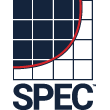191.fma3d
SPEC CPU2000 Benchmark Description File
Benchmark Name
191.fma3d (FMA-3D)
Benchmark Author
Samuel W. Key ([email protected])
For current version and availability information, please contact: Samuel W.
Key
dba KEY Associates
1851 Tramway Terrace Loop NE
Albuquerque, NM 87122
USA
Telephone and Fax: (505) 856-1488
This information is current as of October 1999.
Benchmark Program General Category
Mechanical Response Simulation
Benchmark Description
FMA-3D is a finite element method computer program designed to simulate the
inelastic, transient dynamic response of three-dimensional solids and
structures subjected to impulsively or suddenly applied loads. As an
explicit code, the program is appropriate for problems where high rate
dynamics or stress wave propagation effects are important. In contrast to
programs using implicit time integration algorithms, the program uses a
large number of relatively small time steps, with the solution for the next
configuration of the body being explicit (and inexpensive) at each step. To
further reduce the computational effort, the program has a complete
implementation of Courant subcycling in which each element is integrated
with the maximum time step permitted by local stability criteria. For
simulations that have large differences in element critical time steps over
the mesh, very significant savings in execution time are achieved. There
are no inherent limits on the size of an analysis model, and storage
allocation is dynamic within the code.
The program may be applied to static and quasi-static problems either by
using the dynamic relaxation option or by simply applying the external
loads slowly and integrating the dynamics equations until all significant
transients have died out.
The algorithms and architecture of the program are designed for accuracy
and robustness. The solution portion of the program is in a form suitable
for cache-based computer hardware architectures. The program is written in
Fortran-90 and consists of over 50,000 lines of code and comments. The
program's key features include:
-
Innovative techniques for managing large model databases
-
A complete library of finite elements including rigid bodies
-
An extensive assortment of constraint and loading options
-
Practical sliding interfaces for multi-component analyses
-
Extensive options for model modification during a simulation
-
Transient dynamic analysis using Courant subcycling
-
One-, two- and three-dimensional strain gauges.
Element Library
The program has a large selection of quality finite elements from which to
choose for constructing a model. The element formulations all handle
geometric and material nonlinearities and do not lock for incompressible
materials. The element library has formulations that include:
-
8-Node hexahedral continuum elements.
-
6-Node pentahedral continuum elements.
-
4-Node tetrahedral continuum elements.
-
8-Node quadrilateral thick shell elements
-
4-Node quadrilateral shell elements
-
3-Node triangular shell elements
-
4-Node quadrilateral membrane elements
-
3-Node triangular membrane elements
-
2-Node integrated beam elements
-
2-Node truss elements
-
2-Node spring elements
-
2-Node damper elements
Material Modeling
To simulate realistically a variety of material behavior, the program has a
collection of very practical stress-strain models with well established
integration algorithms. The program's library of material models
includes:
-
Elasticity and plasticity (isotropic and anisotropic)
-
Accurate, smooth hardening plasticity for metal forming
-
Incompressible rubber elasticity
-
Viscoelasticity
-
Volumetric compaction
-
Rate dependence
Input Description
The SPEC Reference input workload is the simulation of an impulsive load
(initial velocity condition) applied to a cylindrical panel (thin shell
structure supported by clamped, simply supported, and symmetry boundary
conditions). A very fine finite element mesh (a large number of finite
elements) is used to obtain a 100 MB RAM-resident data set for the
simulation.
Output Description
Based on the program's ability to provide edited printer output, only
the displacements at two specific nodal points are printed. These two nodal
points are at the edge of the impulsive load where the initial velocity
conditions are discontinuous and, therefore, the response of the
cylindrical panel is initially the most interesting.
Programming Language
Fortran-90
Known Portability Issues
Apart from compiler-specific and machine-specific optimization issues, the
only recommended compiler switch for this version of the program for
general use is -static.
Reference
Key, S. W. and C. C. Hoff, "An Improved Constant Membrane and Bending
Stress Shell Element for Explicit Transient Dynamics," Computer
Methods in Applied Mechanics and Engineering, Vol. 124, pp 33-47, 1995.
Last updated: 11 December 1999




